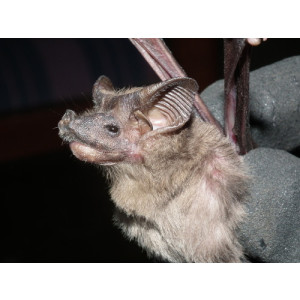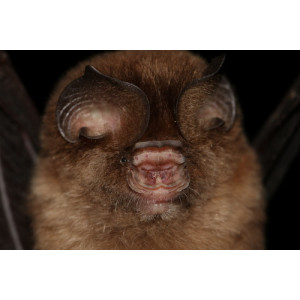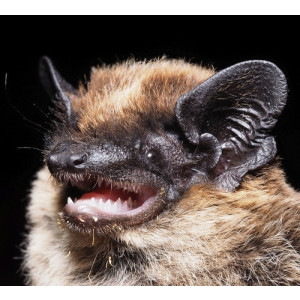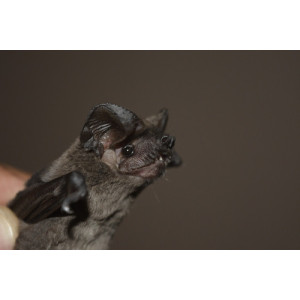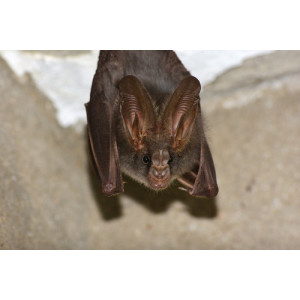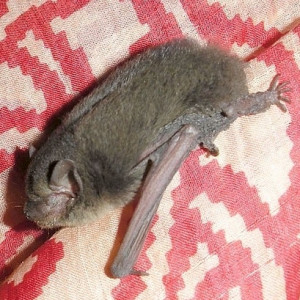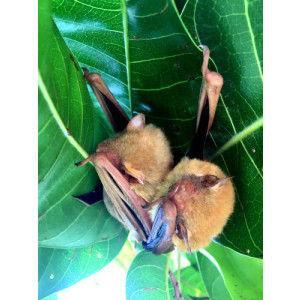Blyth’s Horseshoe Bat Did you see this animal?
Scientific Name : Rhinolophus lepidus
Family : Rhinolophidae
Order : Chiroptera
Class : Mammalia
Phylum : Chordata
Other Name : Horseshoe Bat, Glossy Horseshoe Bat
Habitat : Forest, Caves and Subterranean Habitats (non-aquatic)
Description : Blyth's Horseshoe Bat has a distinctive horseshoe-shaped noseleaf, which it uses for echolocation. This noseleaf helps to focus and direct the bat's high-pitched calls, which bounce off objects and return as echoes to help the bat navigate and locate prey.
They have a grayish-brown fur on their back and a lighter color on their underside. Their fur is short and dense, and they have large, dark eyes.
They have a wingspan of around 25 to 30 centimeters and weigh between 7 and 10 grams.
Blyth's Horseshoe Bat is a nocturnal species that feeds primarily on insects, such as moths, beetles, and flies. They use their echolocation abilities to navigate through dense vegetation and find prey.
They roost in caves, rock crevices, and other sheltered locations during the day, often in small groups of up to 50 individuals.
Breeding occurs during the winter months, with females giving birth to a single pup each year. The young are born blind and rely on their mother's milk for nourishment until they are weaned and able to hunt on their own.
Blyth's Horseshoe Bat is listed as a species of Least Concern by the International Union for Conservation of Nature (IUCN), but like many bat species, they face threats from habitat loss, disturbance of roosting sites, and the use of pesticides, which can reduce insect populations.
They are important ecological indicators, and their presence or absence can be used to monitor the health of forest ecosystems. They also play an important role in controlling insect populations, making them valuable to agriculture and human health.
They have a grayish-brown fur on their back and a lighter color on their underside. Their fur is short and dense, and they have large, dark eyes.
They have a wingspan of around 25 to 30 centimeters and weigh between 7 and 10 grams.
Blyth's Horseshoe Bat is a nocturnal species that feeds primarily on insects, such as moths, beetles, and flies. They use their echolocation abilities to navigate through dense vegetation and find prey.
They roost in caves, rock crevices, and other sheltered locations during the day, often in small groups of up to 50 individuals.
Breeding occurs during the winter months, with females giving birth to a single pup each year. The young are born blind and rely on their mother's milk for nourishment until they are weaned and able to hunt on their own.
Blyth's Horseshoe Bat is listed as a species of Least Concern by the International Union for Conservation of Nature (IUCN), but like many bat species, they face threats from habitat loss, disturbance of roosting sites, and the use of pesticides, which can reduce insect populations.
They are important ecological indicators, and their presence or absence can be used to monitor the health of forest ecosystems. They also play an important role in controlling insect populations, making them valuable to agriculture and human health.
Distribution in Bangladesh
References:
description written by:Asad U. Tanvir,Department of Zoology,Jagannath University,Dhaka; reviewed by:Muntasir Akash,Department of Zoology,University of Dhaka;Taxonomic Checklist:Red List of Bangladesh Volume 2: Mammals, 2015, IUCN; information sources:Wikipedia , iucnredlist.org, photo credit:Samiul Mohsanin, (Jahangirnagar University,Dhaka), photo copyright: Samiul Mohsanin.more information please contact with us.
description written by:Asad U. Tanvir,Department of Zoology,Jagannath University,Dhaka; reviewed by:Muntasir Akash,Department of Zoology,University of Dhaka;Taxonomic Checklist:Red List of Bangladesh Volume 2: Mammals, 2015, IUCN; information sources:Wikipedia , iucnredlist.org, photo credit:Samiul Mohsanin, (Jahangirnagar University,Dhaka), photo copyright: Samiul Mohsanin.more information please contact with us.



